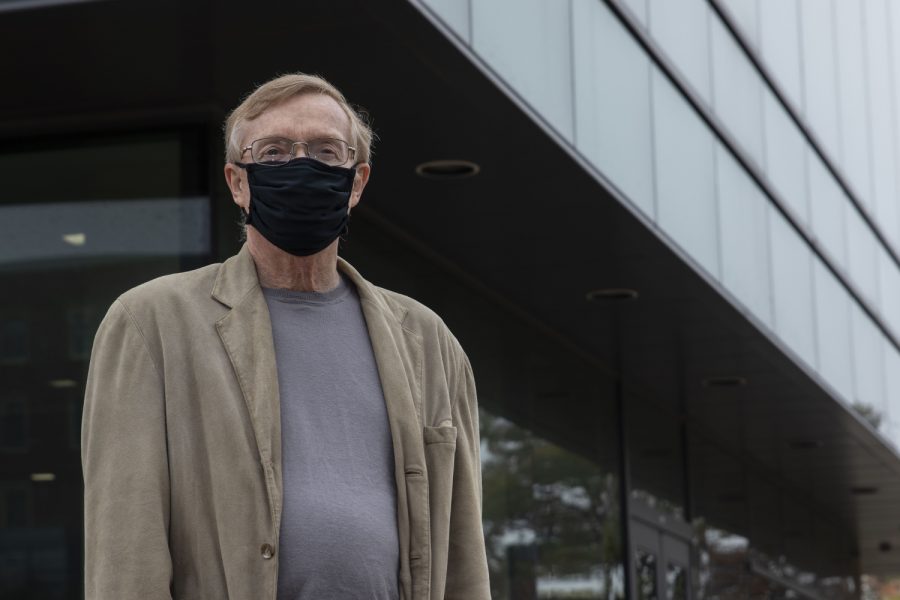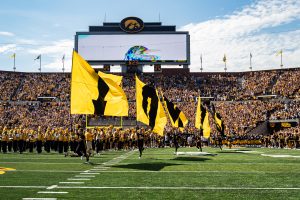Big Ten gives daily dose of COVID-19 precautions to ensure player safety
Athletics programs across the Big Ten are testing players and staff daily to keep everyone safe as they gear up for the beginning of the season.
Chief Infection Officer for Iowa Athletics James Torner poses for a portrait outside of the College of Public Health Building on Thursday, Oct. 22, 2020.
October 22, 2020
With Big Ten football set to begin this weekend, the league has implemented guidelines across each athletics program to ensure the safety of players, coaches, and staff members amid the spread of the coronavirus.
The University of Iowa athletics department, along with the other 13 universities in the Big Ten, began daily COVID-19 testing Sept. 30. Each university has also appointed a chief infection officer to report this data to the Big Ten.
UI epidemiologist and Chief Infection Officer for Hawkeye Athletics James Torner said he’s used to doing surveillance on the virus, as he has been tracking the pandemic since late February. The new protocols are not far off from what UI Athletics implemented in June when athletes began returning to campus to train.
The Big Ten paused all team activities on March 13 because of the pandemic. The Iowa football team was the first Hawkeye program to return to its facilities on June 8. COVID-19 testing began for the team on May 29, and other athletes and coaches would be tested as they returned to campus too. Now, the football team has access to daily testing, as will other Hawkeye sports when they start competing again.
“I think they’re proceeding with caution,” Torner said of the Big Ten. “As long as things are positive, they’ll go ahead.”
A core group of no more than 170 people, including players and a select number of coaches and staff, use a point-of-contact (POC) test for daily testing, Torner said.
Universities are not allowed to buy more tests, and there are around 120 players on each team, leaving around 50 staff members to be tested daily, Iowa Team Physician Andrew Peterson said. There are currently 124 Hawkeye Football players on the roster, leaving 46 tests for coaches and staff.
Head Coach Kirk Ferentz said at a Tuesday press conference that everyone is tested at a set time daily and before travel on certain Fridays. They also test Saturdays before games. He noted that tests across the conference have a 98.9-percent accuracy, and that while the programs cannot be perfect, they have allowed programs to keep playing.
“[Daily testing is] what allowed us to start practicing, to limit the contact tracing issues that were causing so many problems and so many challenges,” Ferentz said.
If the POC test returns a positive result, the person then takes a polymerase chain reaction (PCR) test to confirm the result. Torner said the POC test weeds out negative cases, and the PCR test is used to confirm a positive result.
RELATED: Iowa’s Tyrone Tracy will kneel during national anthem Saturday
The rapid tests are manufactured by Quidel and onsite testing is managed by Biodesix, both of whom have entered strategic partnerships with the Big Ten. Quidel has also partnered with the Pac-12.
Torner and other chief infection officers report this data to the Big Ten weekly. A medical subcommittee receives this data and uses it to make decisions on gameplay and other matters. As The Daily Iowan previously reported, over the week of Oct.12-18 the UI athletics department conducted 660 COVID-19 PCR tests and received six positive tests and 654 negative tests.
Head Football Athletic Trainer Kammy Powell said in an Oct. 8 press conference that athletic trainers have been in charge of testing for Iowa, though with the POC tests people are able to swab their own nose. Between watching out for test results and checking in on players, Powell said she’s never really off the clock.
“Our jobs have definitely doubled as far as workload and kind of what we’ve been responsible for,” Powell said.
If a player or staff member tests positive for COVID-19 with the POC test on game day they are not allowed to participate, even if results of their PCR test comes back negative. This decision came down to fairness, Peterson said, since some teams might get PCR test results back faster than others. The UI usually sees test results returned within four to six hours.
Once someone has a confirmed positive coronavirus test, it will be 21 days before they return to the field. For everyone, whether they are in athletics or not, it’s expected to self-isolate for 10 days following a positive test. After that period, they can come out of isolation, but players cannot return to competition, Peterson said.
Around the 14-day mark, athletes will go through cardiac testing, including visiting a sport cardiologist and having an echocardiogram and cardiac MRI. If all looks well, Peterson said, the players begin a seven-day return to play.
The Big Ten made this process a requirement across the league in its Sept. 16 announcement that a fall football season would be played, but Peterson said this was already standard practice for universities.
“It really just codified what was standard procedure anyway,” Peterson said.
The Big Ten developed thresholds for rates of positivity in athletic programs given by chief infection officers to determine changes to practices or games. For teams, if the positivity rate is from 0-2 percent, they’re in the green. Anywhere from 2 to 5 percent lands teams in the orange, and red is any rate over 5 percent.
The thresholds vary some with the whole team population. If the population positivity rate ranges from 0 to 3.5 percent, they are green. The range of 3.5 to 7.5 percent puts them in the orange, and anything over 7.5 percent is red.
The thresholds these two rates land on at any given time determine whether practices need to be altered, or if teams can even play. If both are in green or only one rate is in orange, no practices need to change. If both rates are in the orange or one is red, the program has to “proceed with caution and enhance COVID-19 prevention,” according to the announcement. If both rates are in the red, the team must stop practices and cannot participate in games for at least seven days.
Torner said the UI has not been required to altar practices due to the number of positive cases in the program or in the community.
Beyond keeping athletes safe, the Big Ten is also looking at the safety of the community.
In his weekly reports to the Big Ten, Torner also includes weekly data on positive COVID-19 tests on the UI campus, in Johnson County, and in Iowa. He also records the number of local hospital beds available just in case an outbreak from a sporting event does occur.
According to a Monday campus update, the UI received 16 self-reported cases of COVID-19 since Oct. 16 from students and staff, for a total of 2,161 cases since the semester began. According to the state’s data, Iowa has seen over 108,000 positive cases, with 5,645 coming from Johnson County.
“I think the decision making [isn’t only] related to the athlete, but also what is the risk to the athlete, and what is the risk of fan exposure,” Torner said.
Hawkeye wide receiver Brandon Smith said he’s never really nervous about getting tests since they get results so quickly. When asked at an Oct. 6 press conference about accountability on the team to be safe and responsible during the pandemic, Smith said everyone knows to wear a mask and practice other precautions.
“Everybody on the team knows how important playing football is … working hard and practicing in all this, and we wouldn’t do anything to jeopardize that,” Smith said





